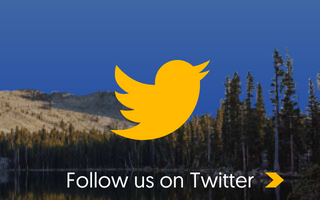Are you looking for high-speed rural Internet?
The Internet is a necessity for many people today. It provides access to information, entertainment, and socializing. For some rural residents, it’s the only way they can stay connected to friends and family outside of their community. But all too often, the wide-open spaces that make up most of rural America are left with limited or no options for high-speed Internet service at all. In this blog post, we will explore different options you have if you’re looking for Internet in a rural area.
The first step to getting Internet in a rural area is finding out what the options are for you.
The rural internet options will depend on where you live. If you’re close enough to city centers or densely populated areas, then there may be more choices available for high-speed service that can get to the homes without any trouble at all.
The topography of rural communities will also have a significant effect on access to high-speed Internet. Wide-open plains, dense forests, desert valleys, or rocky mountains will change how internet service can be delivered to rural areas.

Fixed-Wireless Broadband
This rural internet service uses mountains and hills to broadcast signals from towers at those sites to receivers or antennas on homes. This receiver then connects to your computer or router. With fixed-wireless broadband, you can access the Internet from anywhere as long as there is a signal. This type of Internet Service Provider (ISP) typically requires line-of-sight to the broadcasting tower.
Conifer Communications is an example of a company that provides such service in rural areas. It was started by a group of friends who wanted to be able to game together.
Fixed-Wire internet
Fixed wire internet falls into three categories, Fiber internet, Cable internet, and DSL or phone line-based Internet. While DSL may be available throughout most of the county, cable internet is generally available in populated areas. Cable companies also offer broadband services, but they are often more expensive than DSL plans and may not extend as far outside urban areas. And Fiber internet is the least widely available as it is the most costly per foot during installation.
The speed of service for DSL and Cable broadband can vary significantly from one community to the next and one home to the next. Cable has even been reported to have slower download and upload speeds than DSL in some cases. But when the line doesn’t go through a relatively populated area (like near an urban center), cable is generally faster because it’s not being shared with as many people.
For rural areas without broadband internet connection options, satellite might be a good solution if there’s no other alternative available.

Satellite internet
Satellite does not require cables or wires because the signal is sent from one part of the country to another via satellites orbiting Earth which means that coverage extends anywhere within line of sight of these satellites.
Satellite internet is the most common for very rural residents who have little to no other choices. The speeds can vary greatly but generally provide enough speed for basic web browsing or emailing but not much else. The most painful and costly issue with satellite service is data plans. Often data is highly metered and can be very expensive. If you’re looking for video streaming services like Netflix or Hulu+, then this isn’t the right choice as streaming a single movie can swallow up all the data allotted for a month. The other downside to satellite internet is that it has a high latency – this means there’s quite a lag time between when you transmit something online and when it appears on your screen (something like 150-200 milliseconds).
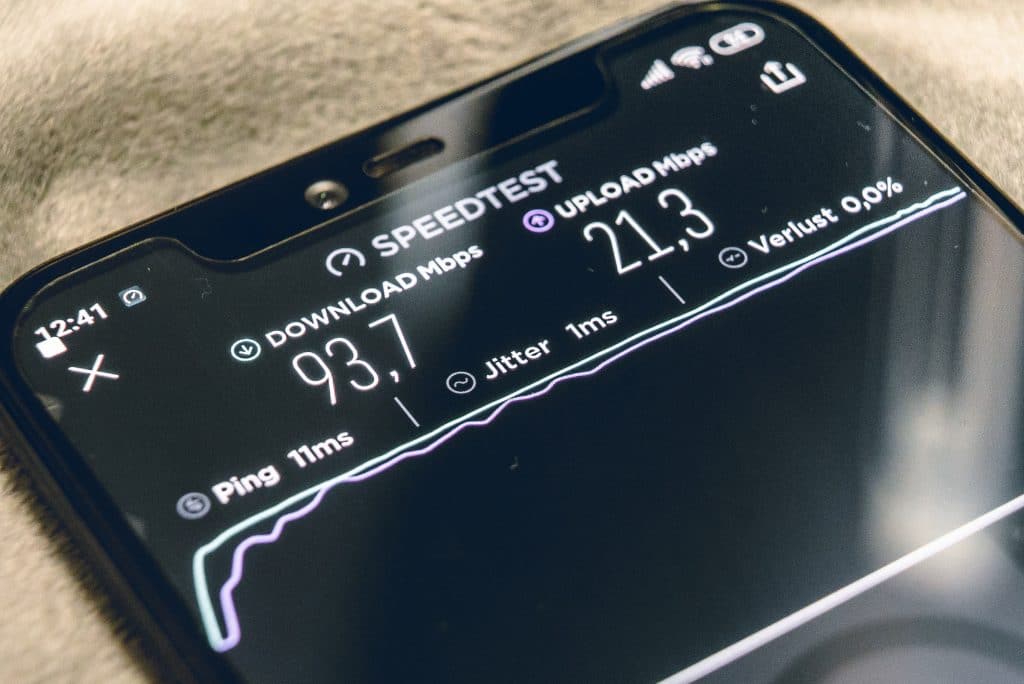
Mobile broadband
Mobile broadband allows you to connect with your phone’s data plan through a cell tower. Mobile broadband is typically only offered by the big three providers: Verizon, AT&T, and Sprint. Mobile broadband requires line-of-sight to an antenna tower, or you can buy signal enhancing equipment like amplifiers that stick outside your house to collect signals under challenging circumstances – for instance, if there are lots of trees blocking your phone’s connection with the nearest tower.
Mobile broadband is a popular option because you can take your phone anywhere. If you only use a small amount of data, it may be more affordable than traditional home internet. The downside to mobile broadband is that the speeds are often much slower than what you would get through a fiber or DSL connection – from about 500kbps for downloads (about one-tenth of most people’s cable download speed) up to 12Mbps.

Wifi Hotspots
Cable companies also offer Wi-Fi hotspots with some download/upload speeds ranging up to 30 Mbps which may be more expensive than DSL or satellite options. You’ll still need a cable TV subscription for this feature though – so make sure your provider offers both when comparing packages before signing up!
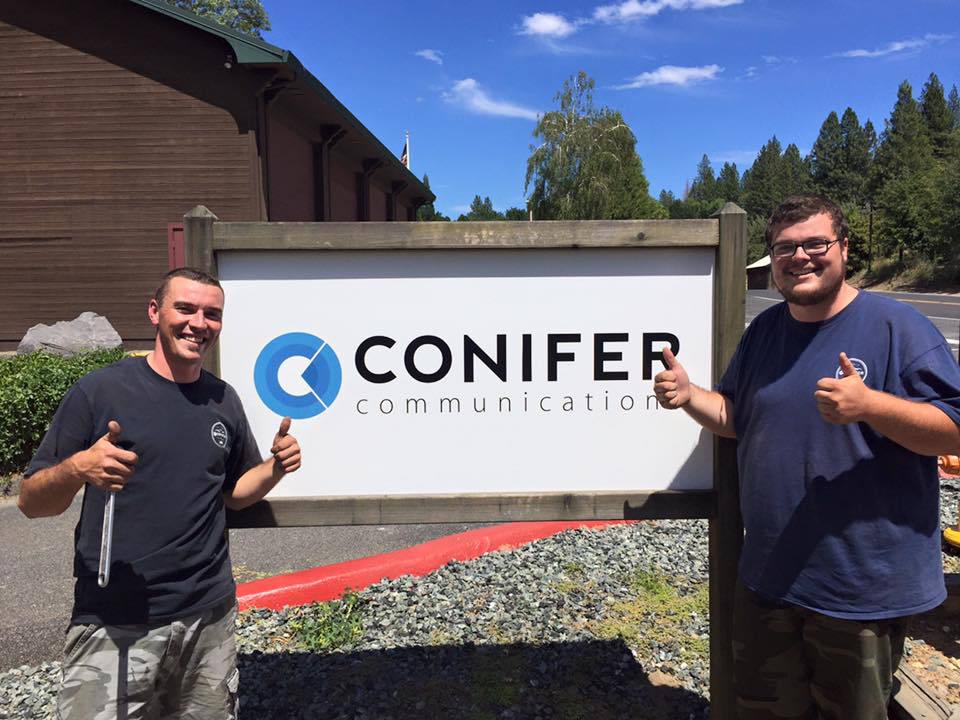
Local Wifi Hotspots
You could also try connecting through WiFi hotspots at libraries, coffee shops, restaurants, and other places where they offer free WiFi access, but this may be limited depending on what the establishment offers its customers. Some establishments limit their internet access to just those who are paying customers, so having a pre-paid plan might come in handy as well in these situations.
Many rural areas have cell phone coverage but no internet access. If you are in a location where there is only cell phone coverage, keep your battery charged and make sure to contact the place of business or find an alternate solution for accessing critical information when needed.
Once you review what internet service providers are available in your area, you will need to determine what sort of speed package is right for you so that you can adequately compare offerings amongst your local internet providers.

How to choose the right internet speed package
What does Mbps stand for and how many should I have?
You could also try connecting through WiFi hotspots at libraries, coffee shops, restaurants, and other places where they offer free WiFi access, but this may be limited depending on what the establishment offers its customers. Some establishments limit their internet access to just those who are paying customers, so having a pre-paid plan might come in handy as well in these situations.
Many rural areas have cell phone coverage but no internet access. If you are in a location where there is only cell phone coverage, keep your battery charged and make sure to contact the place of business or find an alternate solution for accessing critical information when needed.
Once you review what internet service providers are available in your area, you will need to determine what sort of speed package is right for you so that you can adequately compare offerings amongst your local internet providers.
What Are Mbps?
Megabits per second is an important factor in calculating the speed of your internet plan. Megabits per second, or MBPS, is a data unit denoted by a number that indicates how quickly your network can download information.
The higher the bandwidth of your internet service, the more you can download in a given amount of time. It’s sometimes called a multi-lane highway because it gives you more options to get places faster.
Many people believe there is no difference between Mbps and MBps, but understanding the distinction can make a world of difference.
Although it might seem like just a typo, MBps is actually different from Mbps.
- MBps is megabytes per second.
- Mbps is megabits per second.
- Megabits tells you the speed of a connection in a fixed amount of time.
- Megabytes tell you how much data you can download or upload in that same amount of time.
One byte is 8 bits. So you can find out how many megabytes of data you can download, by dividing your Mbps by 8.
If you have 100Mbps, then it means that your computer can download data at 12.5MBps. That is for every second. If your Internet is slow, you need some more Mbps (megabytes per second). But it’s not that simple.
While bandwidth and speed are related, the most common metric for evaluating internet performance is Mbps. Which means:
- Bandwidth is the maximum amount of data (packets) that a channel can take in one time. It’s like how much water can flow through a pipe in one time.
- On the other hand, throughput is how much data you are able to send through your internet connection in a specific time period.
This means that your internet might not be as good as it seems. It might have a lot of problems, like network latency and packet loss.
Many rural areas have cell phone coverage but no internet access. If you are in a location where there is only cell phone coverage, keep your battery charged and make sure to contact the place of business or find an alternate solution for accessing critical information when needed.
Once you review what internet service providers are available in your area, you will need to determine what sort of speed package is right for you so that you can adequately compare offerings amongst your local internet providers.

Three Different Factors Can cause slow Internet
If you have problems with video buffering, websites loading slowly or if you keep getting disconnected from playing games, you will need to test your network performance.
You might not be able to fix your internet speed just with more Mbps. You need a speed test to find out how much you have. If it is slow, other things are wrong too and a high number of Mbps will not help.
So if your download and upload are acceptable, what else can cause this? To thoroughly test your network performance, you will have to measure the following:
- Throughput – This is how much data is being transmitted per second (what is referred to as the current speed of your network). In the example above, you have 117Mbps download and almost 15Mbps upload, which is close enough to the advertised bandwidth of 120Mbps/15Mbps.
- Network Latency – Latency is how fast data packets get to their destination. If you use streaming services like Netflix, you need low latency. You can measure it with the “ping time.” 20 ms ping is good for anything and 100 ms ping is usually tolerable.
- Packet Loss – This result tells you if all of your data packets reach their destination. You want to have no packet loss at all. If you do, this will cause slow speeds, disconnects and long loading times.
- If you use a PC, try this test. Hit the Windows button and type in “cmd” to start Command Prompt. Once there, enter the command to ping your computer’s IP address. When you start Command Prompt, type in “ipconfig” and hit Enter. Look for “IPV4 address
A user might experience packet loss and latency when the network cable is too far away from their computer. Always make sure to check the distance when choosing an internet package. Remember that satellite service has a high latency because data has to travel from space back to Earth before returning again.
Once you have enough internet coverage, it’s safe to choose your internet package.
How Many Mbps Do I Need?
Every time you use the Internet, it costs a lot of bandwidth. It depends on how you use your Internet and how many devices in your house are using the Internet. If you watch movies on a tablet or TV that is not 4K, then it will cost less than if they were watching movies on their TV that is 4K.
The higher the definition, the more MBs per second need to be downloaded (streamed) for you to enjoy a buffering-free experience. The more users your household has or the more devices that are connected at one time, the more bandwidth and Mbps you will need.
Many rural areas have cell phone coverage but no internet access. If you are in a location where there is only cell phone coverage, keep your battery charged and make sure to contact the place of business or find an alternate solution for accessing critical information when needed.
Once you review what internet service providers are available in your area, you will need to determine what sort of speed package is right for you so that you can adequately compare offerings amongst your local internet providers.
How to Determine the Amount of Mbps You Need
You use more of your bandwidth when you are streaming a 4K video than when you are browsing on your PC. Browsing rarely takes more than 1 or 2 Mbps, but streaming 4K videos might take as much as 60Mbps and more.
Think about how you spend your time when you’re online. Are you playing games and streaming? Do you have a TV that is 4K at home? Are there people living with or near to you in the house?
All these factors affect the amount of Mbps you need. The more people there are in your house, or using the Internet, the more Mbps you need. All of them will take a chunk of your bandwidth.
Water use is like this. If you have a lot of water going in at the same time, you will not get enough pressure to use all of it. This is also true with the internet. When many devices are on at the same time, with a small speed package, then it will be very slow for each device.
This means that if you are doing 4K movie, playing games on a console, and talking to someone on Skype at the same time, you will need 100Mbps. To find what type of internet connection you want, think about what else you do with your computer. Then look at the table above to see how much bandwidth is needed for your activities.
Different types of people have different preferences for internet service. People who are gamers and live in rural areas will like fixed wireless broadband. It provides high-speed broadband internet and low latency, without cables, phone lines, or satellite dishes.
Conifer Communications gives you seven residential plans with different speeds- from 5Mbps to 30Mbps. The higher-speed packages may be more expensive, but they’re worth it if you do any downloading or streaming videos over the weekends because they’ll save you time waiting on those downloads and video streams. Plus these faster connections will decrease lag which is essential when playing games online.
Gamers who live in rural areas should look into fixed wireless Internet as it’s a much cheaper and more convenient option than traditional cable, satellite, or phone line connections.
– Fixed Wireless Internet offers high-speed broadband without cables, telephone lines or satellite dishes
– This type of service is perfect for those living in rural areas because it can be less expensive than other options like cable
– For gamers looking to play games online with minimal lag time, getting the higher-priced packages may be worth the investment if they have lots of downloads or streams over weekends
Many rural areas have cell phone coverage but no internet access. If you are in a location where there is only cell phone coverage, keep your battery charged and make sure to contact the place of business or find an alternate solution for accessing critical information when needed.
Once you review what internet service providers are available in your area, you will need to determine what sort of speed package is right for you so that you can adequately compare offerings amongst your local internet providers.
WI-FI
No matter the type of internet provider you chose, you are likely to want (and need) a wi-fi system inside your home. While it can be helpful to hardwire (run a direct line from the service coming into your home to a device) to your primary computer, gaming system, or tv, most of the devices in our homes are wireless. This means you will need a Wi-Fi router. Your internet provider may provide this, or you may purchase your own. There are many different options of routers out there for different needs, from covering large areas with mesh networks to gaming needs. There are many details to consider, but that is a whole other conversation for another day.
Internet Fixed Wireless Providers, more info!
Here at Conifer, we’re called a WISP, Wireless Internet Service Provider, also known as a Fixed Wireless Internet Provider. We provide fixed wireless internet service versus hardline or satellite (we’ll explain those in a bit). Fixed Wireless is one of the fastest-growing internet service options in America. We provide speeds ranging from 5 to 30 Mbps for residential customers and can offer up to 1 Gig (that’s 1000 Mbps) for Enterprise setups.
More on what Fixed Wireless internet is
In a world that is increasingly becoming more wireless, Fixed Wireless internet has become the most popular form of high-speed Internet. To grasp this technology and its many advantages, you must first understand how it works. Fixed Wireless service operates by broadcasting radio waves from strategically placed towers at various locations in our area.
We have a network of towers on hilltops that send out the internet connection wirelessly to our customers; that signal is received via a radio antenna we install on your home/building. This creates an effective network for transmitting data-like webpages, streaming Netflix movies-on-demand, or even browsing social media platforms like Facebook! There are two types: “Point To Point” (PTP), where one tower transmits signals to another specific location, and “Dense Wave Division Multiplexing”/multiple-input multiple-output (MIMO).
A line-of-sight is required from your location to one of our towers. Because of the nature of the geographical area we live in with all of our beautiful hills, mountains, and valleys, line of sight can sometimes be tricky, and there are areas we can’t serve.
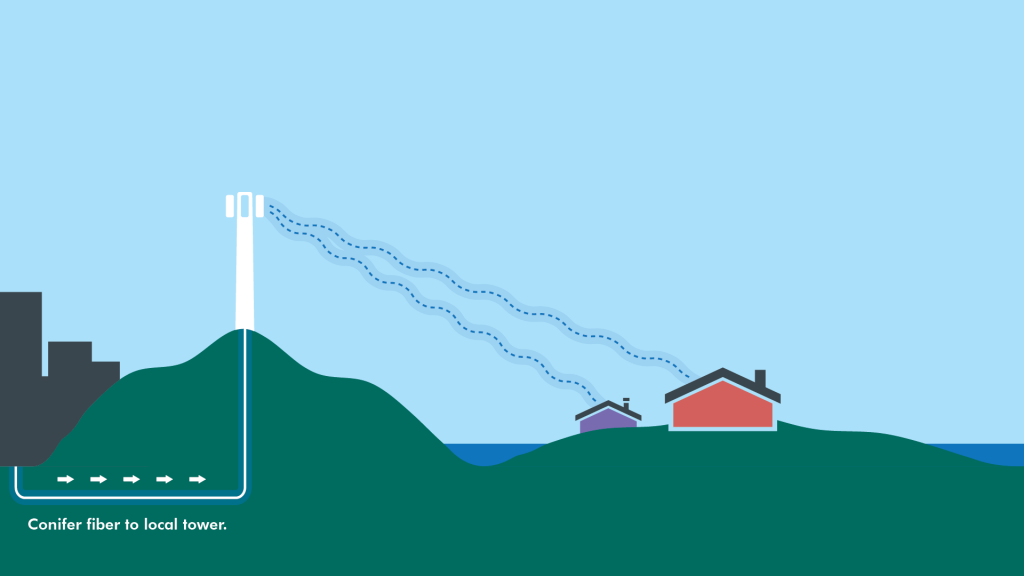
Technically, how does Fixed Wireless work?
Radio waves are transmitted from a tower to foster an internet connection. Unlike Cable, DSL, or Fiber Optic which all use some form of in-ground wiring to transmit signals – Fixed Wireless relies on exterior antennas that pick up radio signals from the closest provider and then travel through your home system converting them into WiFi connections. Now, we use Fiber connections for a second feed to support many of our towers. This allows us to have a redundant and robust system.
Fixed Wireless service is an excellent option for rural areas as the low density of our rural landscape makes it very expensive to install the classic wired form of internet service. We also have our great local topography to aid in the fixed wireless delivery. When we can place a tower on a local mountain or hilltop, the fixed wireless signal can connect homes for up to 15 miles.
We have a network of towers on hilltops that send out the internet connection wirelessly to our customers; that signal is received via a radio antenna we install on your home/building. This creates an effective network for transmitting data-like webpages, streaming Netflix movies-on-demand, or even browsing social media platforms like Facebook! There are two types: “Point To Point” (PTP), where one tower transmits signals to another specific location, and “Dense Wave Division Multiplexing”/multiple-input multiple-output (MIMO).
A line-of-sight is required from your location to one of our towers. Because of the nature of the geographical area we live in with all of our beautiful hills, mountains, and valleys, line of sight can sometimes be tricky, and there are areas we can’t serve.
How is Fixed Wireless internet different from Satellite Internet, again?
Fixed wireless and satellite internet are two very different entities. Both require a dish or antenna to broadcast a web connection, but they employ other technologies that make them quite distinct from one another. Satellite internet works by using geosynchronous satellite transmitters orbiting satellites in orbit around the planet.
To be fair and honest: satellite is the only kind of service some folks can get because of their hard-to-reach location, but expensive as providers commonly require data limits. The process of delivering Satellite internet service is more complicated than fixed wireless not only because it involved equipment in space, but also because it requires three dishes; one attached on your property, suspended up above as well as helping cut out any other interference coming into play at an ISP’s hub station with its own dish attached there too. Satellite internet service requires the data to travel many miles before reaching a customer. So while satellite providers can get signals back pretty well, there will always be some delays when sending messages or videos through that much space.
Fixed Wireless service is an excellent option for rural areas as the low density of our rural landscape makes it very expensive to install the classic wired form of internet service. We also have our great local topography to aid in the fixed wireless delivery. When we can place a tower on a local mountain or hilltop, the fixed wireless signal can connect homes for up to 15 miles.
We have a network of towers on hilltops that send out the internet connection wirelessly to our customers; that signal is received via a radio antenna we install on your home/building. This creates an effective network for transmitting data-like webpages, streaming Netflix movies-on-demand, or even browsing social media platforms like Facebook! There are two types: “Point To Point” (PTP), where one tower transmits signals to another specific location, and “Dense Wave Division Multiplexing”/multiple-input multiple-output (MIMO).
A line-of-sight is required from your location to one of our towers. Because of the nature of the geographical area we live in with all of our beautiful hills, mountains, and valleys, line of sight can sometimes be tricky, and there are areas we can’t serve.

What are the pros and cons of Fixed Wireless Internet?
Pros of Fixed Wireless internet
- Availability in our rural areas: Fixed wireless broadband is a perfect option for rural areas that do not have access to cable, or fiber-optic Internet and is often just as price competitive.
- No phone line necessary: Fixed wireless Internet is a cost-effective broadband option that requires no phone lines or direct physical connections. (That means no paying for a landline number that you never use.)
- Low latency: In contrast to Satellite or Fiber, Fixed Wireless signals travel shorter distances and offer lower latency rates.
- No Standard Weather Issues: Standard rain or snowstorms, offer no resistance to the delivery of a Fixed Wireless signal.
- Unlimited Data: Most internet service providers enforce some form of data cap. We have no data limits. Your data usage is completely unlimited!
Cons of Fixed Wireless internet
- Line of sight fragility: Fixed wireless Internet connections require an exterior antenna in direct sight with one of our towers. (Though new technology allows us to cut through trees but not dense forest)
- Extreme Weather interference: Some of our towers are at high elevations, and when the towers are iced over in the winter, we can do nothing but wait for the ice to melt before the signal can be fully restored. High levels of smoke in the air from wildfires can have a diminishing effect on the signal.
- Service and equipment cost: Monthly and initial startup costs for Fixed Wireless service may be higher than Internet other packages and types monthly fees of subsidized internet services such as cable or DSL from phone companies. Our pricing depends on how much bandwidth you need so you can find a point to balance your budget.
To be fair and honest: satellite is the only kind of service some folks can get because of their hard-to-reach location, but expensive as providers commonly require data limits. The process of delivering Satellite internet service is more complicated than fixed wireless not only because it involved equipment in space, but also because it requires three dishes; one attached on your property, suspended up above as well as helping cut out any other interference coming into play at an ISP’s hub station with its own dish attached there too. Satellite internet service requires the data to travel many miles before reaching a customer. So while satellite providers can get signals back pretty well, there will always be some delays when sending messages or videos through that much space.
Fixed Wireless service is an excellent option for rural areas as the low density of our rural landscape makes it very expensive to install the classic wired form of internet service. We also have our great local topography to aid in the fixed wireless delivery. When we can place a tower on a local mountain or hilltop, the fixed wireless signal can connect homes for up to 15 miles.
We have a network of towers on hilltops that send out the internet connection wirelessly to our customers; that signal is received via a radio antenna we install on your home/building. This creates an effective network for transmitting data-like webpages, streaming Netflix movies-on-demand, or even browsing social media platforms like Facebook! There are two types: “Point To Point” (PTP), where one tower transmits signals to another specific location, and “Dense Wave Division Multiplexing”/multiple-input multiple-output (MIMO).
A line-of-sight is required from your location to one of our towers. Because of the nature of the geographical area we live in with all of our beautiful hills, mountains, and valleys, line of sight can sometimes be tricky, and there are areas we can’t serve.
How fast is Fixed Wireless service?
Fixed Wireless service has the potential to reach speeds up to 1,000 Mbps. One of our most popular internet plans for residential customers is our Standard speed package of 9 Mbps download and 5 Mbps upload. Just like any other service, the speed you see one device in your home will depend on what else is using the connection in your home: how many devices are occupying your web connection such as gaming consoles or streaming media; security cameras; smart devices.
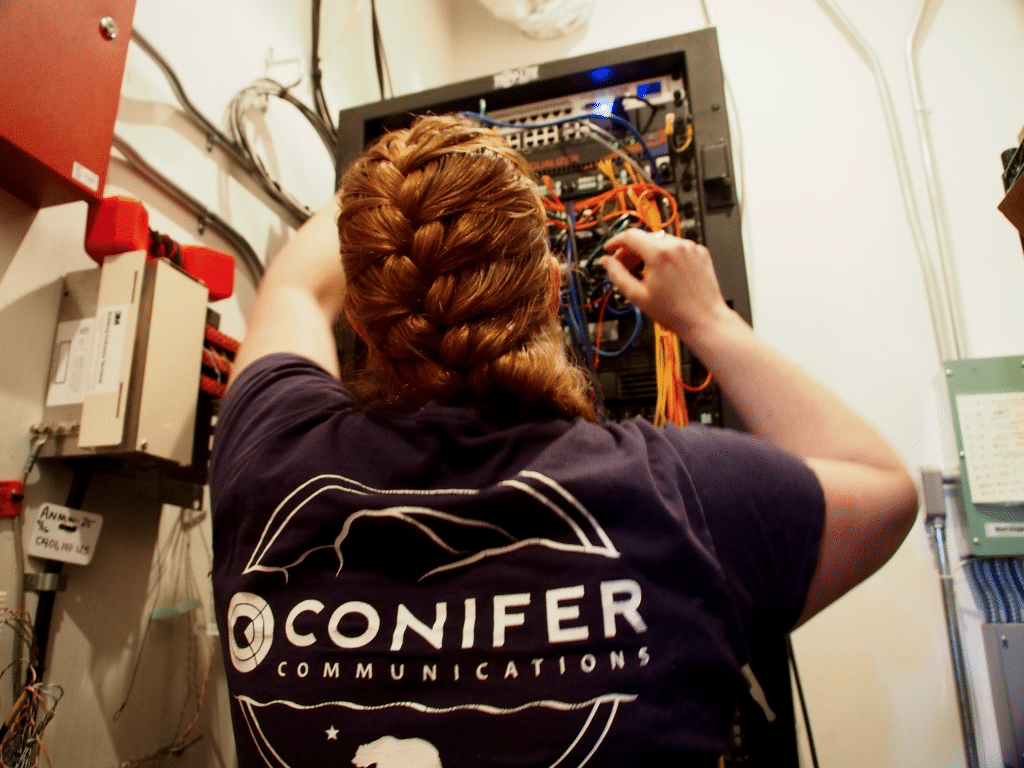
Steps For Your Installation
Fixed Wireless internet is installed by our technicians who come to your home, set up the service by mounting a small wireless antenna or dish on the exterior of your house.
We try to make installations as quick and easy as possible. The steps below walk you through the process. Thanks for your patience in bearing with us through the ever-changing COVID regulations; anytime we need to enter your home, we will be wearing masks, gloves, and plenty of sanitizer. We’ll also be keeping our distance. Please don’t take it personally.
We check line-of-sight
Our techs will check your location for line-of-sight to one of our towers. If they can’t get one, of course, there will be no charge for the attempt. If they can get one, then we move on to step 2.
Install
Next, an antenna that looks like a satellite, will be mounted facing the tower. We will then run a wire from the antenna to a router located inside your home.
Connect
Then our techs program the antenna and router and confirm that everything is working correctly at the desired speed.
If you don’t have access to high-speed home internet service, it may be time for a change. Fixed Wireless is one of the best rural internet options available today and offers many benefits that other services do not provide. For example, there are no monthly data usage limits; satellite connections often have restrictions on how much data can be used in a given month. Satellite also has slower speeds than wireless connections, so if your business needs fast upload and download speeds, then Fixed Wireless would likely work better for you. To see if your area qualifies or not, check out our coverage map to see what the best internet service is available in your area [here.]






